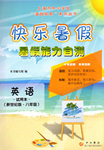题目内容
Scientists from China, Sweden and the United Stated have developed a high-producing rice that can reduce methane emission(甲烷排放), a major greenhouse gas blamed for global warming, from rice fields, according to a paper published on the latest issue of Nature.
By inserting a barley(大麦) gene into rice, Sun Chuanxin and his colleagues created SUSIBA2 Rice, which stores more starch(淀粉) in the section of the rice above ground, according to a paper published on the latest issue of Nature.This means the grains will have more starch while the root will exude less nutrients that will later be turned into methane by microbes(微生物) in the soil, Sun, who works with Swedish University of Agricultural Sciences, told Xinhua.
"It solves two major problems mankind faces at one time: environmental degradation and the need for increased grain output," Wang Feng, another scientist, said, adding that the rice can cut methane discharge by more than 90 percent during summer and more than half during autumn, as "the rice displays a greater emission reduction effect in high temperatures." Meanwhile, small-scale trials have also suggested an increased output: a single plant of the new breed has 300 more grains with a starch content 10 percent higher. Wang said the team is working on applications for the rice in different areas, seasons and using different farming techniques. "It's still far away from mass application, but at least we see the light of hope."
Human-induced methane, though less abundant than carbon dioxide in the air, is responsible for 20 percent of the global warming effect. Rice paddies are the largest single source of methane linked to human activity. According to the Ministry of Agriculture, China produces 209 million tons of rice in 2014, or 28 percent of the world's total of 734 million.
1.SUSIBA2 Rice will be a major breakthrough because _______.
A. it tastes with a barley flavor
B. it well balances environmental protection and grains increase
C. it contains more starch than the ordinary rice
D. it gives off less methane in summer than in winter
2.What can we learn from the text?
A. Scientists will soon grow the new rice in large areas
B. Human-related methane contributes most to global warming
C. China may contribute greatly to global warming reduction
D. Rice fields will be reduced all over the world
3.The purpose of this writing is to ________.
A. ask people to cut down on their dependence on rice consumption
B. draw people’s attention to the serious consequences of global warming
C. introduce a new kind of genetically-modified rice and its possible benefits
D. indicate human-related methane alone is to blame for global warming effects
 Happy holiday欢乐假期暑假作业广东人民出版社系列答案
Happy holiday欢乐假期暑假作业广东人民出版社系列答案 快乐暑假暑假能力自测中西书局系列答案
快乐暑假暑假能力自测中西书局系列答案
